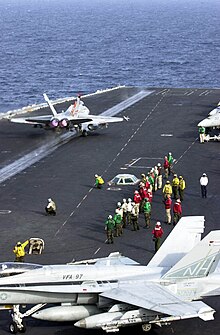CATOBAR: Difference between revisions
m Unref stub now merely unref, since not a stub. using AWB |
No edit summary |
||
| Line 13: | Line 13: | ||
[[Category:Aircraft carriers]] |
[[Category:Aircraft carriers]] |
||
[[Category:Naval aviation technology]] |
[[Category:Naval aviation technology]] |
||
[[Category:Types of take-off and landing]] |
|||
[[ar:كاتوبار]] |
[[ar:كاتوبار]] |
||
Revision as of 04:48, 1 March 2011
This article needs additional citations for verification. (December 2009) |


CATOBAR (Catapult Assisted Take Off But Arrested Recovery) is a system used for the launch and recovery of aircraft from the deck of an aircraft carrier. Under this technique, aircraft launch using a catapult assisted take off and land on the ship (the recovery phase) using arrestor wires. Although this system is more costly than alternative methods, it provides greater flexibility in carrier operations, since it allows the vessel to support conventional aircraft. Alternate methods of launch and recovery can only use aircraft with STOVL or STOBAR capability. Only three countries still operate carriers that use the CATOBAR system; the U.S. Nimitz class, and USS Enterprise (CVN-65), France's Charles De Gaulle, and Brazil's NAe São Paulo. The Future French aircraft carrier is planned to be built as CATOBAR. In order to save money, the British Queen Elizabeth class aircraft carriers were originally to be built as STOVL carriers operating the F-35B Lightning II, but subsequent to the Strategic Defence and Security Review they are now to be CATOBAR carriers capable of supporting the non-STOVL F-35C variant. India's second aircraft carrier of Vikrant class is planned to be of 65,000 tons and to utilise steam catapults.[1][2]
